When it comes to Thanksgiving Turkey recipes you want something easy that makes a flavorful, juicy, turkey every time — enter this dry-brined turkey recipe. It’s so easy you’ll never make a roast turkey any other way.
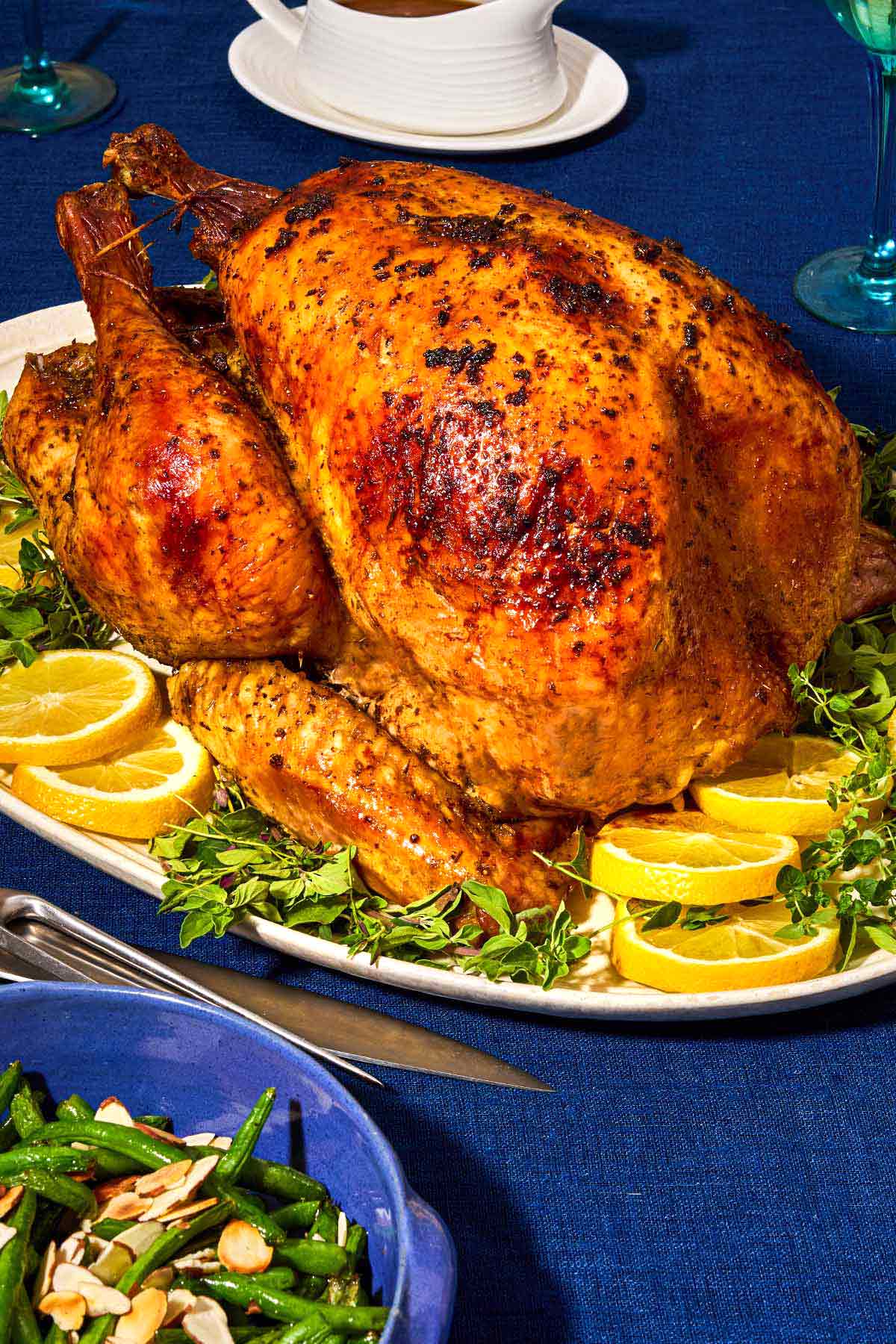
The hallmark of a good roast turkey recipe is tender juicy meat, with crispy golden skin and unbeatable flavor, and hands down the easiest and best way to achieve a Thanksgiving turkey where everyone asks for seconds is to dry brine it.
For this turkey recipe, I use a similar technique to my whole roasted chicken recipe, where I create an herbal salt paste and coat the turkey under the skin, over the skin, and inside the cavity. I cover the bird and leave it in the fridge for 24 and up to 48 hours. The rub infuses the turkey with lemon, oregano, garlic, and thyme. The salt in the rub seasons the meat and retains moisture. Dry brining a turkey is far easier than using a wet brine and yields incredible results every time.
Place a 12-pound Thanksgiving turkey in your refrigerator to thaw 5 days before you plan to roast it. On day 4 apply the dry brine, cover, and let sit in the fridge for 1 more day. When ready, roast your turkey, and soak up all of the “oohs” and “ahhs” from family and friends when you bring your dry-brined turkey to your holiday table.
Table of Contents
- Ingredients Needed for Dry Brined Turkey
- Step-by-Step Guide to Dry Brined Turkey
- What’s The Difference Between a Wet Brine and a Dry Brine?
- Ingredient Spotlight
- Tips for Thawing Your Thanksgiving Turkey
- The Best Salt For a Dry Brine Turkey Recipe
- What to Serve on Turkey Day!
- More Holiday Roasts
- Lemon Oregano Roasted Turkey Recipe
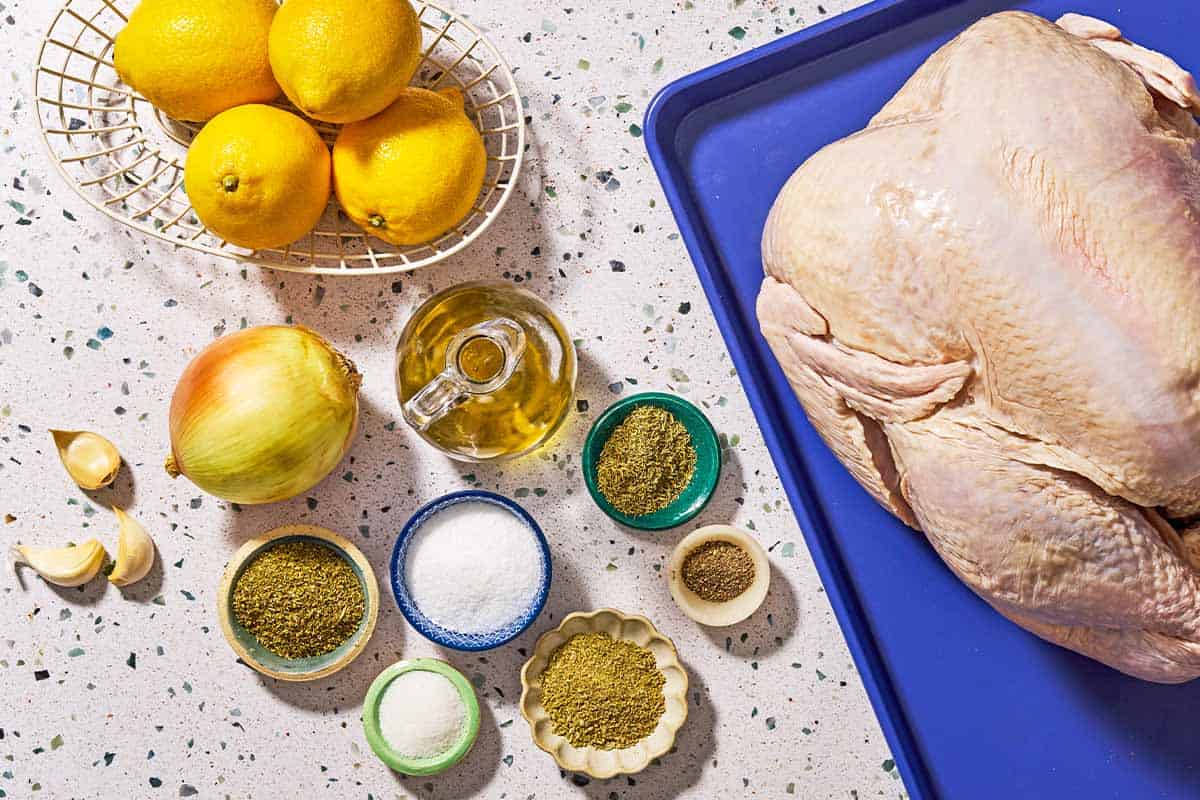
Ingredients Needed for Dry Brined Turkey
The ingredient list is pretty short. I don’t even use fresh herbs for anything other than decorating the platter.
- Garlic: I’m not sure you can make a Mediterranean-inspired roast turkey recipe without garlic. When combined with the other ingredients it provides a rich complex flavor to the Turkey without overpowering it.
- Extra virgin olive oil: Serves two purposes, it helps crisp the outside skin while keeping the meat tender.
- Lemons: Lemons are one of my favorite ingredients to use with any poultry. It adds a sharp, bright flavor. I use the juice in the dry-brine and stuff the cavity with them to add additional moisture to the bird.
- Kosher salt: Salt plays the most important role in a dry-brined turkey. It forces the meat to release its moisture then resorbs it back into the meat along with the infused seasonings which creates a tender, juicy Thanksgiving turkey.
- Spices like Oregano, ground fennel, dried thyme: Speaking of seasonings, I use dried herbs because they are easier to work with when making a rub and have a more concentrated flavor. If you can’t find ground fennel, just use fennel seed and grind it in your spice grinder.
- Sugar: It’s just a touch to balance the acid from the lemon.
- Freshly ground black pepper: The earthy warmth of black pepper contributes to the depth of flavor.
- Whole turkey: Any turkey will work. The one I use for this recipe is about 12-14 pounds. Make sure you thaw it completely before adding the rub. You’ll also want to remove the giblets, and neck from the cavity.
- Yellow onion: I use yellow onion to stuff the cavity because they have a sweetness to them.
- Fresh herbs: These are entirely optional. I just use them to decorate the platter before serving
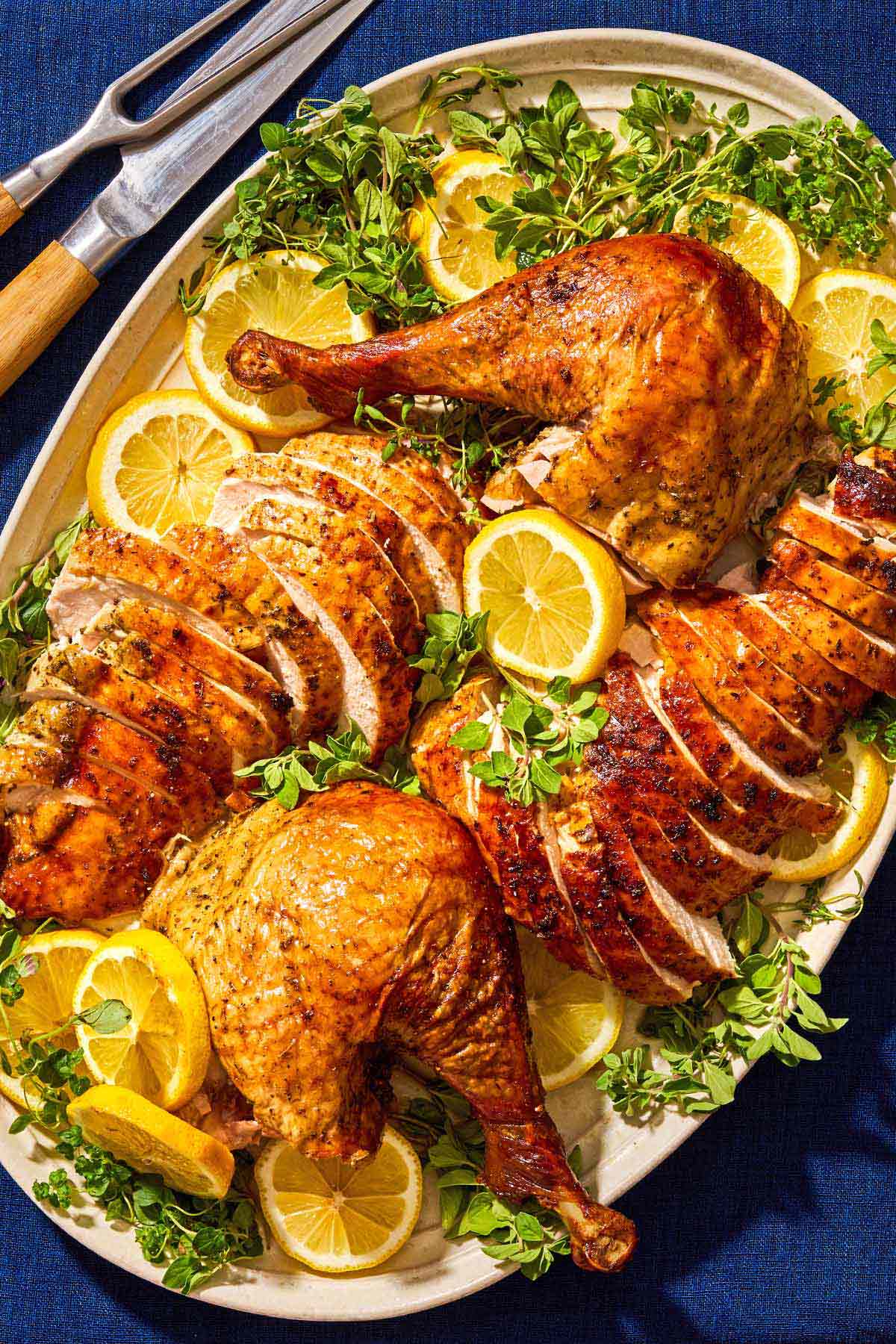
Step-by-Step Guide to Dry Brined Turkey
- Prepare the rub: In a small bowl. Combine minced garlic, olive oil, salt, zest from 2 lemons, 3 tablespoons of lemon juice from 1 of the zested lemons, oregano, fennel, thyme, sugar, and black pepper. Quarter the other lemons and set aside. You’ll use them to stuff the cavity of the turkey later.
- Dry-brine the turkey: Remove the neck and giblets from the bird and discard or use to make gravy. Pat the turkey dry inside and out with paper towels. Place the turkey on a platter, or rimmed baking large enough to hold the bird but small enough to fit in your refrigerator. Gently lift the skin up from the breasts and use your fingers to separate the skin from the breast meat and leg meat. Massage the rub into the meat under the skin, on top of the skin, and inside the cavity of the turkey.
- Refrigerate: Wrap the turkey in plastic wrap and store in the refrigerator for at least 24 hours and up to 48 hours. The salt in the rub penetrates the meat keeping it juicy.
- Heat the oven: Position a rack in the bottom third of the oven. Preheat the oven to 425°F.
- Prepare the turkey: Remove and discard the plastic wrap. Set the turkey breast side up on a roasting rack set inside a roasting pan. Place the quartered lemons and quartered onion inside the cavity of the bird. Use butcher’s twine to truss the Turkey or tie the legs together and tuck the wings under the body so they don’t burn. Season skin with an additional sprinkle of salt and pepper.
- Roast the turkey: Place the turkey in the hot oven and roast for 20-30 minutes. The skin will start to turn golden brown. Reduce the heat to 350°F and cook for an additional 60 minutes.
- Rotate, baste, and cover the turkey: All ovens are different. It’s best to rotate the pan 180 degrees to ensure even cooking. Use a baster to draw up any fluids from the bottom of the pan and squeeze it over the breast. Tent the breast with foil to prevent overcooking it. Roast for another 60 minutes. The turkey is ready when an instant-read thermometer inserted into the thickest part of the thigh reads 160°F.
- Remove the turkey and let it rest: Remove the turkey from the oven, and let it rest for 15 to 20 minutes. The temperature should rise to 165°F through carryover cooking.
- Serve: Carve and serve with your favorite sides.
What’s The Difference Between a Wet Brine and a Dry Brine?
Dry brining, also known as curing or salting, skips the water bath and instead, you rub the turkey down with a salted, seasoning paste and let it rest for at least 24 hours. The function of salt is critical to the overall moisture of the turkey because it causes the meat to release moisture by changing the structure of proteins in the meat. This then allows the bird to resorb the salty liquid giving you the juiciest, most tender, and superflavorful Thanksgiving turkey on the planet.
Most people are familiar with the idea of brining also called wet brining. It involves submerging the turkey (or chicken) in a saltwater solution and letting it sit there for 24 hours. This is relatively easy to do with a chicken, but a little more challenging when it comes to turkey. Either you are doing this in a huge container or a cooler in the garage. Wet brining works, but it’s messy, and the bird is moist but almost soggy.
Ingredient Spotlight
This Thanksgiving turkey recipe was inspired by the flavors of Greece, the brightness of lemon, garlic, olive oil, and oregano found in dressings like the ever-versatile Lodolemono.
Most grocery store oregano is Italian and sometimes you can find Mexican oregano as well. While both are delicious in their own right, Greek oregano has my heart. It has a bright, citrusy, and robust flavor that I love in fresh salads, pizzas, bread, fish, and chicken. It’s powerful so a little goes a long way (another reason why I love it.)
- Try it: Visit our shop for true Greek Oregano grown and sustainably harvested in Greece.
- Best substitute: Italian or Mexican oregano.
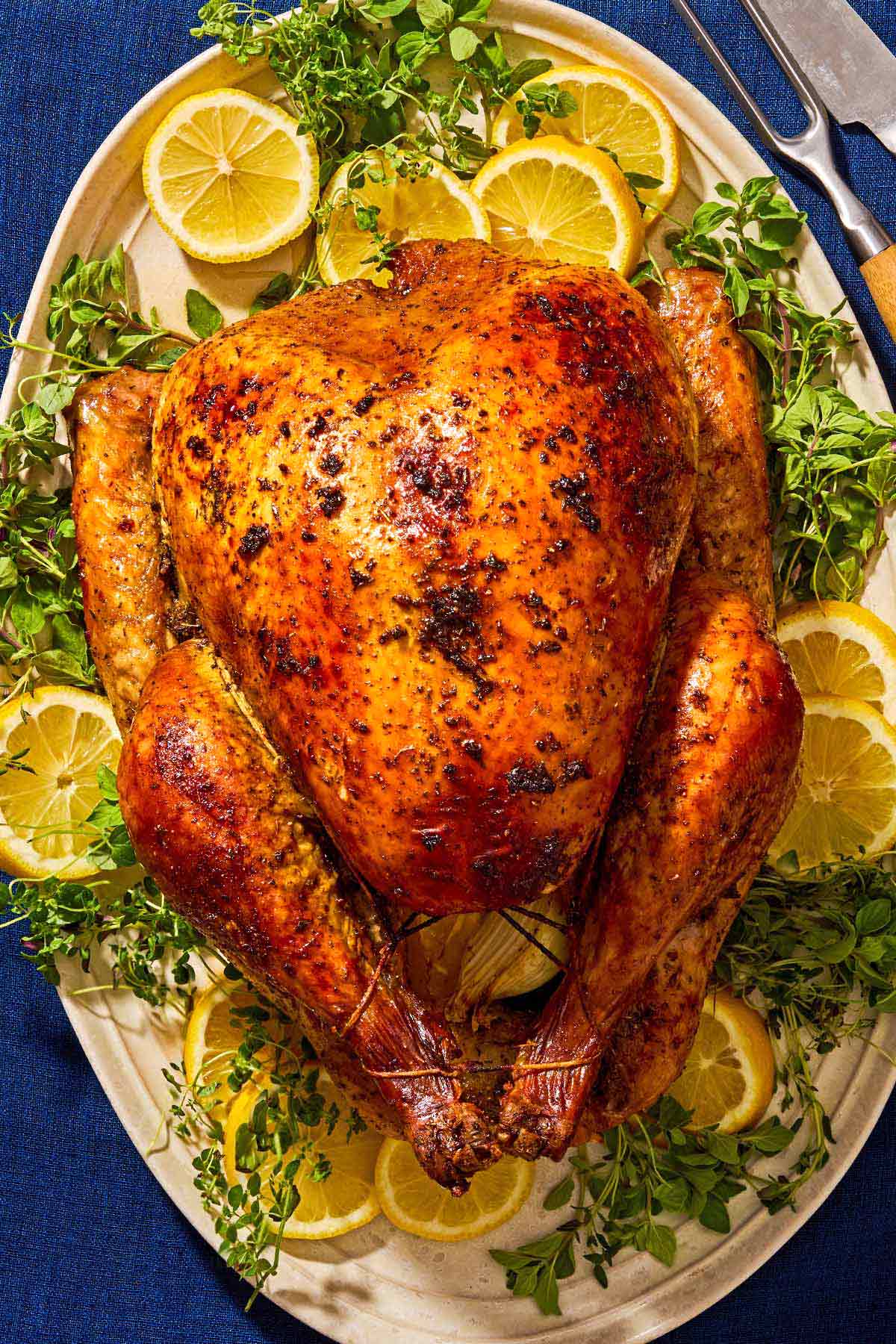
Tips for Thawing Your Thanksgiving Turkey
- Plan on 24 hours for every 4 pounds of bird, so if your turkey is 12 pounds you will need 3 days to thaw it, and 1 additional day to let it dry brine.
- Never thaw your turkey on the counter. Let it thaw in the refrigerator.
- If you’re coming down to the wire and need to thaw your turkey quickly, fill your sink with cold water and put the turkey breast side down (still in its packaging). It should be completely submerged. Plan for 1 hour per pound of bird. Make sure you change the water frequently to keep it cold and thoroughly clean the sink and counters when it’s done.
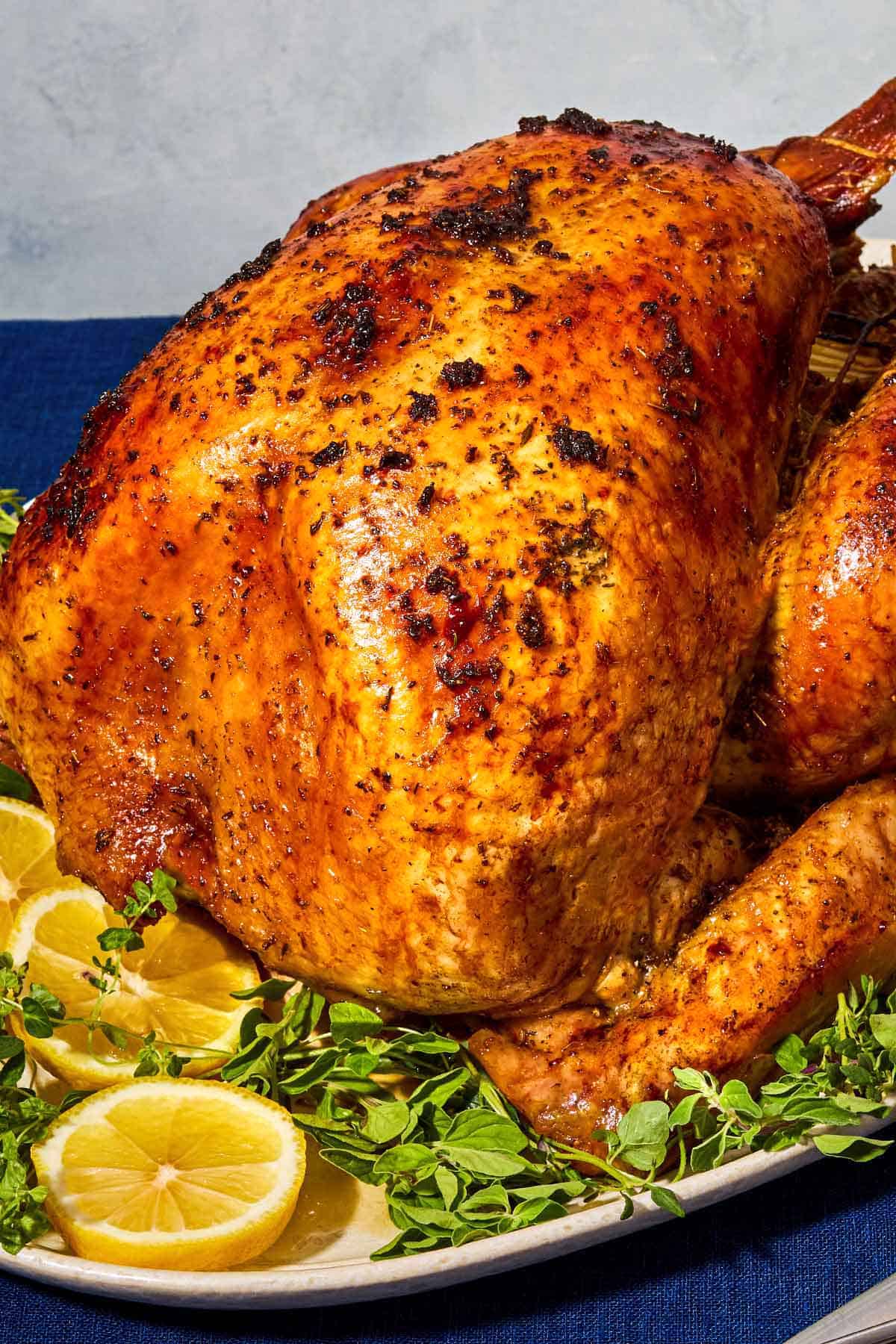
The Best Salt For a Dry Brine Turkey Recipe
Using 3 tablespoons of kosher salt for a 12 to 15-pound turkey is plenty enough to ensure juicy, well-seasoned meat. That’s less than 3/4 teaspoon of salt per pound of meat for a 12-pound bird, and considering 4 ounces is a common serving size for Turkey, when you break down the salt it’s roughly equivalent to less than 1/5 teaspoon of salt per serving.
- Always use kosher salt. Its granules are larger and it has a mild flavor.
- Not all kosher salt is the same. The two most common brands—Morton Kosher Salt and Diamond Crystal Salt have different-sized granules. I use Morton Kosher Salt. If you use Diamond Crystal salt increase the amount of salt in this recipe by 1 teaspoon.
- Never swap table salt in for kosher salt. Table salt has small granules and a tinny taste. It would result in too much salt for this dry brine turkey recipe.
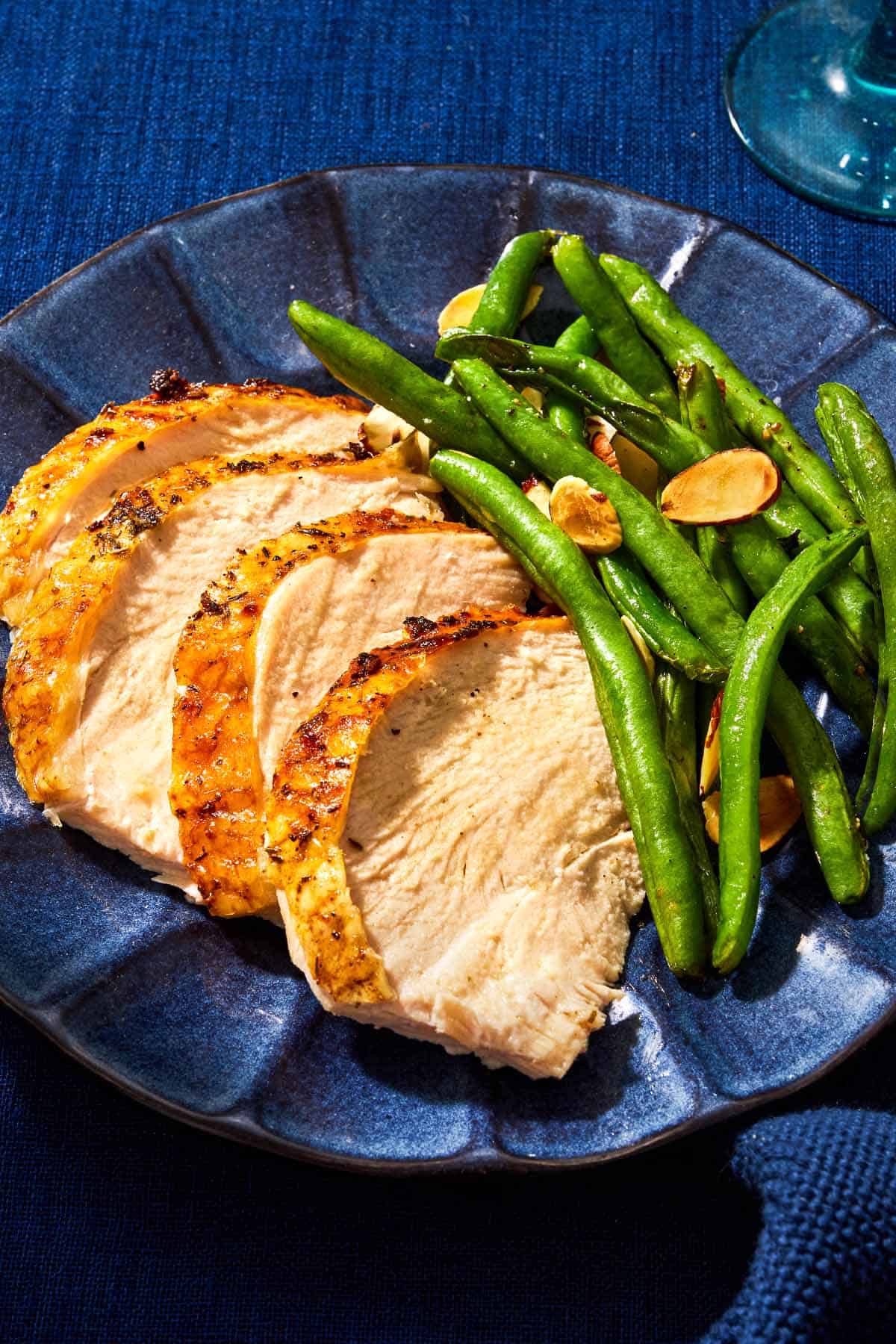
What to Serve on Turkey Day!
Don’t get me wrong this post is all about the prized Thanksgivig turkey, but we all know how important the sides dishes are!
I like to balance my holiday feast with a combination of rich dishes and fresh light dishes. Because I use fennel this turkey rub this Roasted Fennel side dish is a favorite. I round it out with this Stuffed Vegetable Acorn Squash recipe, which doubles as a main for my vegetarian family members, and these Roasted Garlic Mashed Potatoes are always on the list. I use buttermilk in the recipe which lightens them up a bit and I use any leftovers to make Mashed Potato Pancakes the next day. And, of course, you can’t forget Roasted Brussels Sprouts.
So those are my rich dishes, I also like to have something fresh on the table and these 3 salads always make the rotation: Kale Salad with Roasted Pistachios and Parmesan is a great make-ahead salad and everyone loves it. Endive always feels festive to me and I’m partial to bitter salads paired with sweet fruit so this Endive Salad with Citrus makes the cut and adds a gorgeous pop of color. Then I finish things off with this Celery salad. It’s quick easy and affordable. Just wait to dress it right before serving.
When it comes to dessert certain things are required: Pumpkin and Cheesecake. I know it’s a travesty on Thanksgiving but we really aren’t pie people. Last year I made this Baklava Cheesecake and everyone is already asking for this year. I’m going to go all in and make this Baklava Pumpkin Pie and then a lighter Italian Pear Cake. If we have a gluten-free guest this Flourless Chocolate Cake will make an appearance.
More Holiday Roasts
Meat and Poultry
Roast Turkey Breast with Garlic and Herbs
Meat and Poultry
Cranberry Chicken
Meat and Poultry
Roast Rack of Lamb Recipe with Garlic and Herb Crust
Browse all Mediterranean recipes.
Visit Our Shop.
Lemon Oregano Roasted Turkey
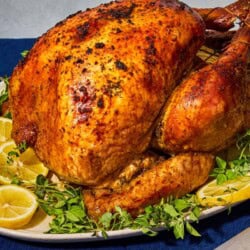
Ingredients
- 3 garlic cloves, minced
- 3 tablespoons extra virgin olive oil
- 3 lemons
- 2 tablespoons kosher salt
- 2 tablespoons dried oregano
- 1 tablespoon ground fennel
- 1 tablespoon dried thyme
- 2 teaspoons sugar
- 2 teaspoons freshly ground black pepper
- 1 (12-14 pound) turkey
- 1 yellow onion, quartered
Instructions
- Prepare the rub: In a small bowl. Combine minced garlic, olive oil, salt, zest from 2 lemons, 3 tablespoons of lemon juice from 1 of the zested lemons, oregano, fennel, thyme, sugar, and black pepper. Quarter the other lemons and set aside. You’ll use them to stuff the cavity of the turkey later.
- Dry-brine the turkey: Remove the neck and giblets from the bird and discard or use to make gravy. Pat the turkey dry inside and out with paper towels. Place the turkey on a platter or rimmed baking sheet large enough to hold the bird but small enough to fit in your refrigerator. Gently lift the skin up from the breasts and use your fingers to separate the skin from the breast meat and leg meat. Massage the rub into the meat under the skin, on top of the skin, and inside the cavity of the turkey.
- Refrigerate: Wrap the turkey in plastic wrap and store it in the refrigerator for at least 24 hours and up to 48 hours. The salt in the rub penetrates the meat and keeps it juicy.
- Heat the oven: Position a rack in the bottom third of the oven. Preheat the oven to 425°F.
- Prepare the turkey: Remove and discard the plastic wrap. Set the turkey breast side up on a roasting rack set in a roasting pan. Place the quartered lemons and quartered onion inside the cavity of the bird. Use butcher’s twine to truss the Turkey or tie the legs together and tuck the wings under the body so they don’t burn. Season skin with an additional sprinkle of salt and pepper.
- Roast the turkey: Place the turkey in the hot oven and roast for 20-30 minutes. The skin will start to turn golden brown. Reduce the heat to 350°F and cook for an additional 60 minutes.
- Rotate, baste, and cover the turkey: All ovens are different. It’s best to rotate the pan 180 degrees to ensure even cooking. Use a baster to draw up any fluids from the bottom of the pan and squeeze it over the breast. Tent the breast with foil to prevent overcooking it. Roast for another 60 minutes. The turkey is ready when an instant-read thermometer inserted into the thickest part of the thigh reads 160°F.
- Remove the turkey and let it rest: Remove the turkey from the oven, and let it rest for 15 to 20 minutes. The temperature should rise to 165°F through carryover cooking.
- Serve: Carve and serve on a platter decorated with sliced lemons and herbs then with your favorite sides.
Notes
Nutrition
Bundle and Save!
Four of our best-selling signature olive oils, perfect for everyday use.
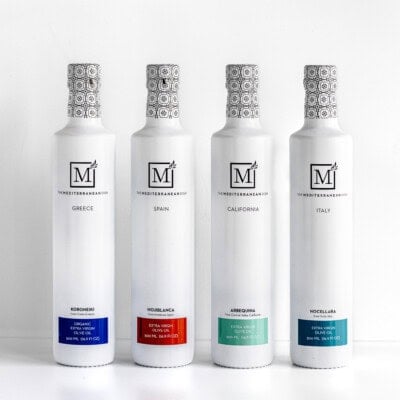
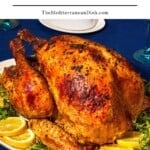

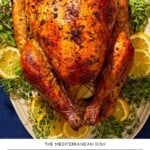
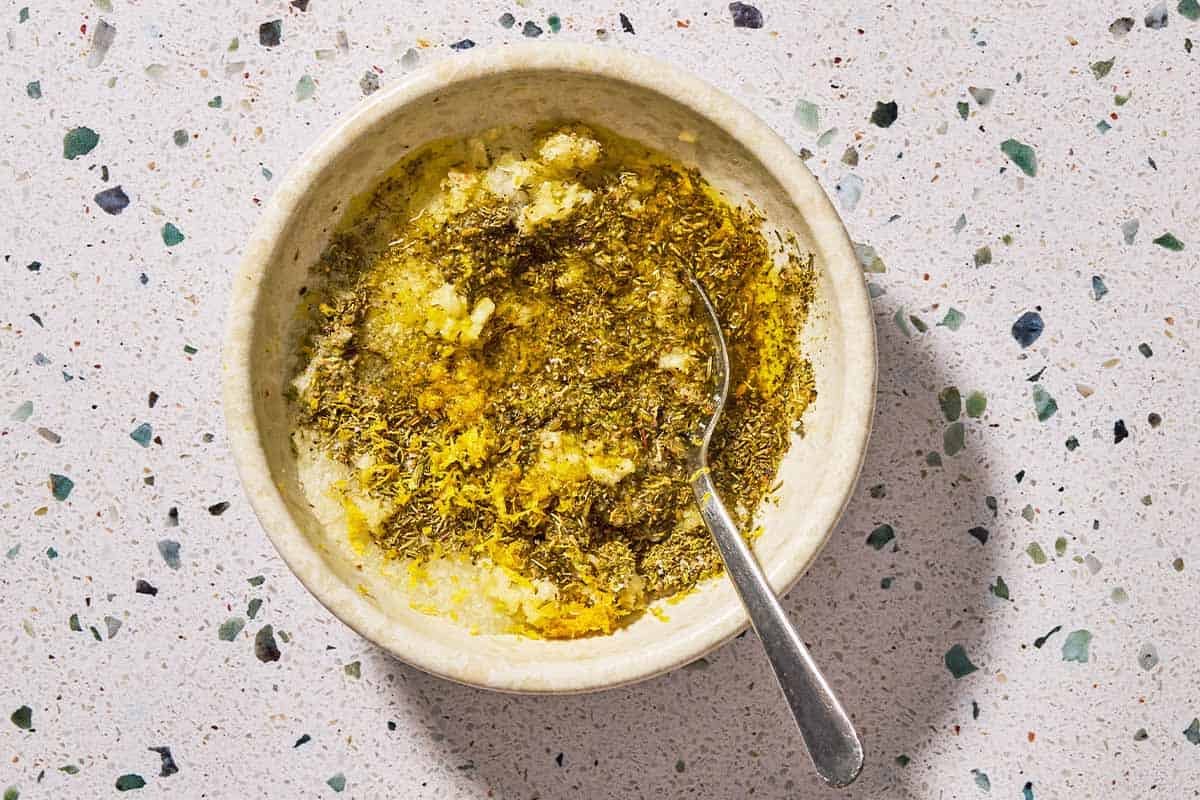
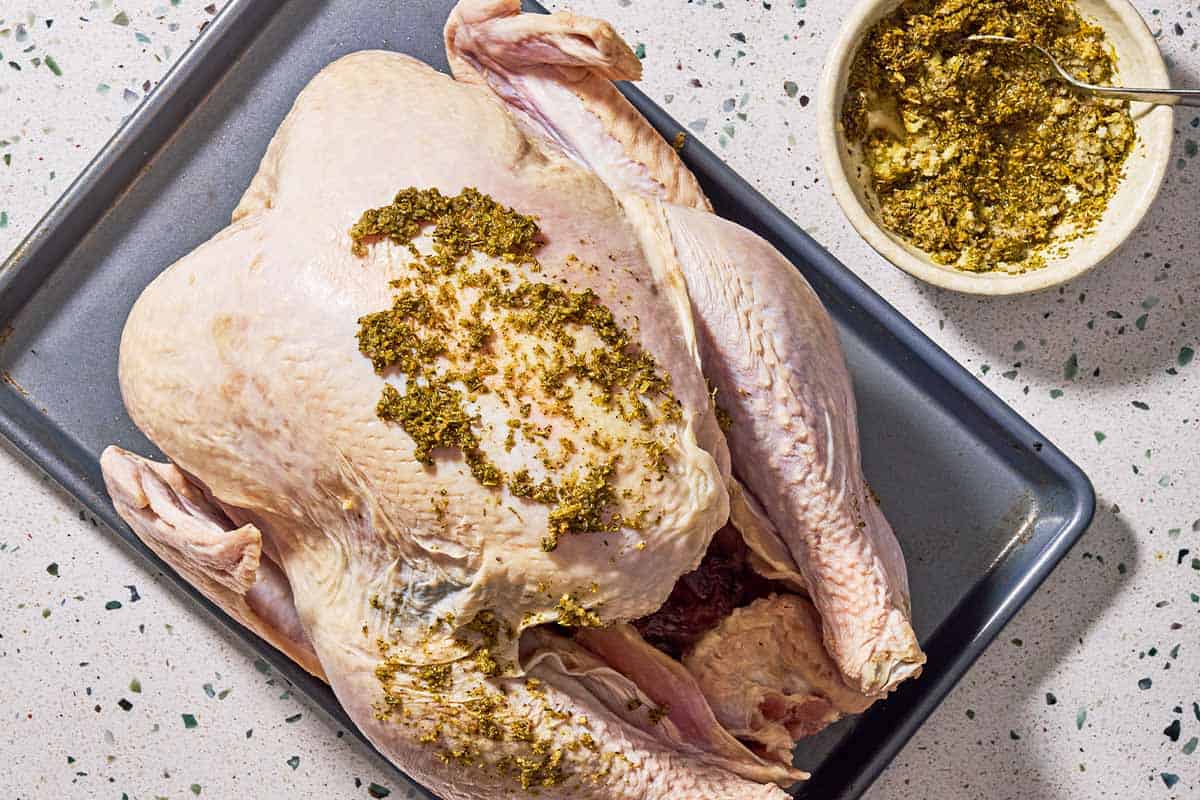
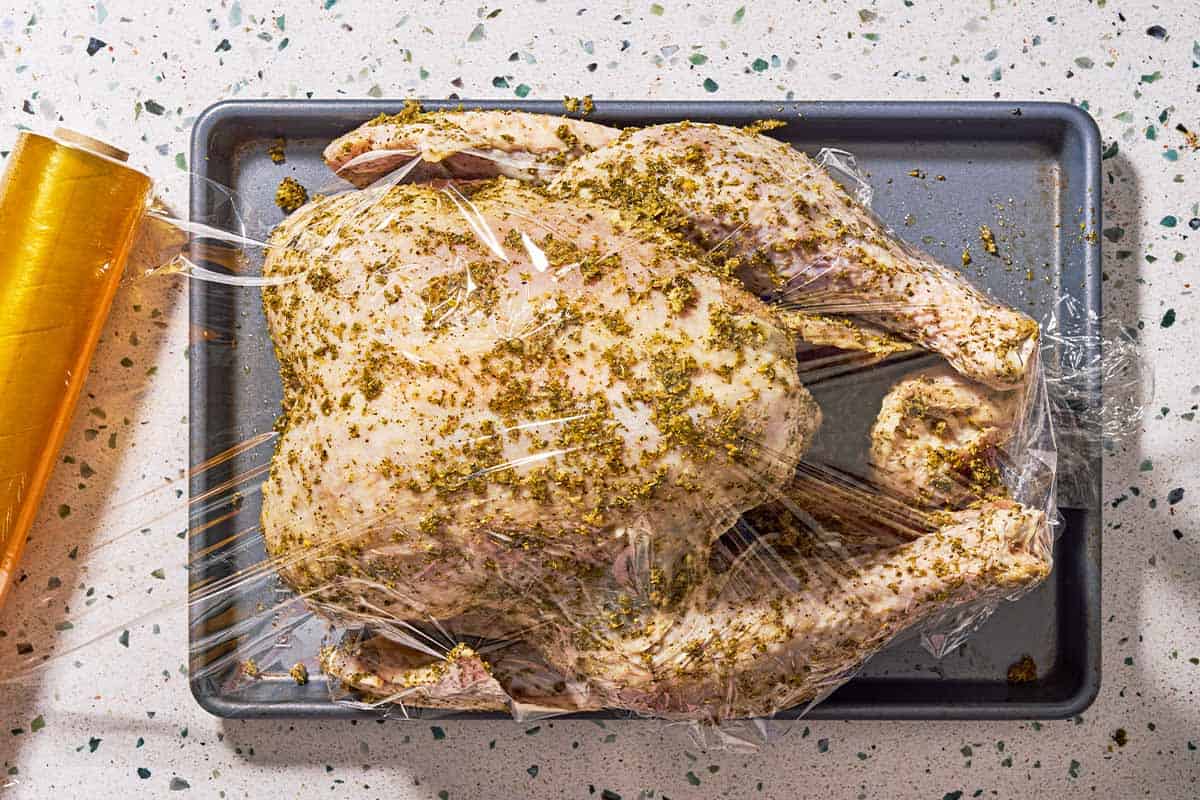
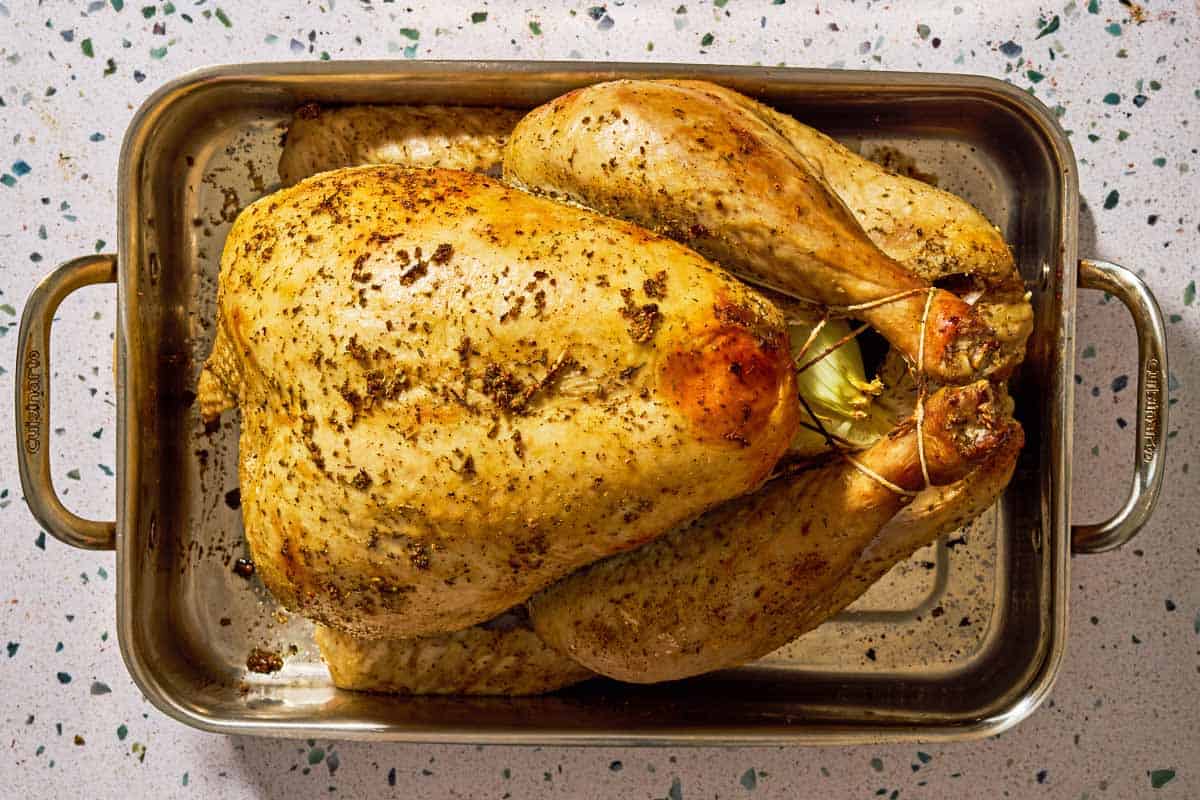
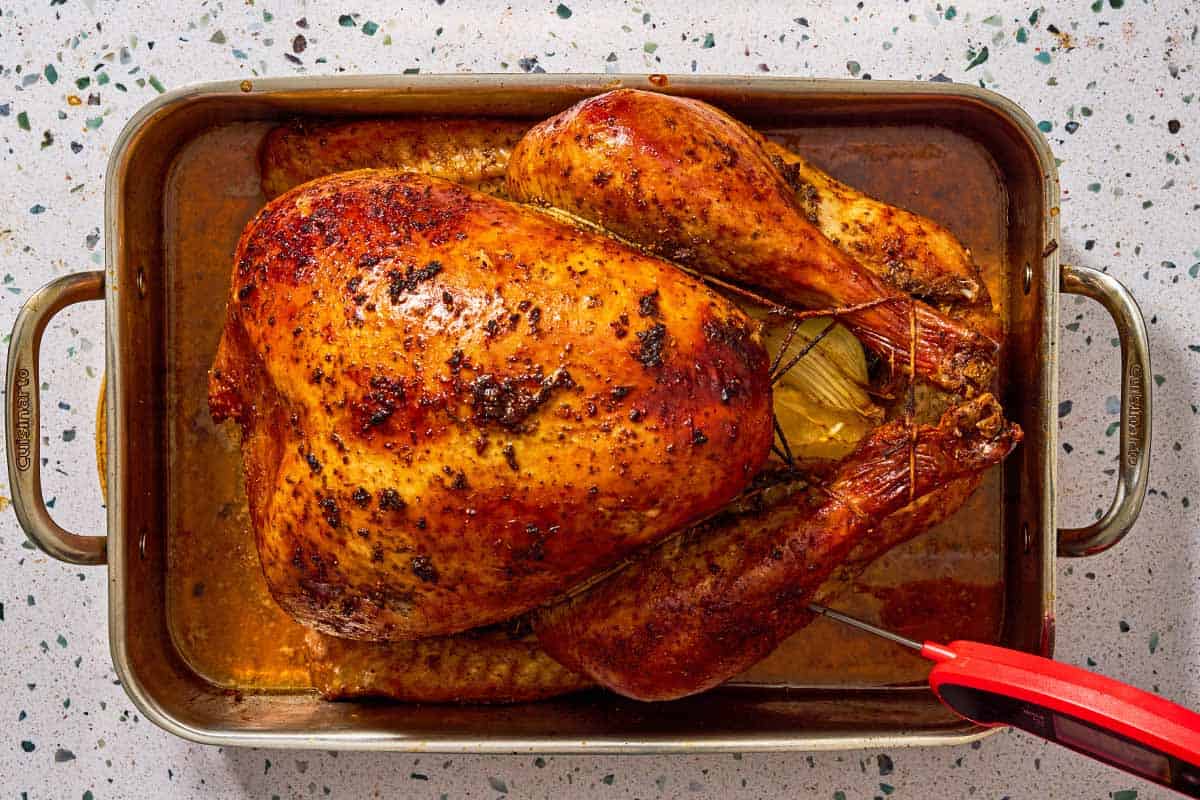
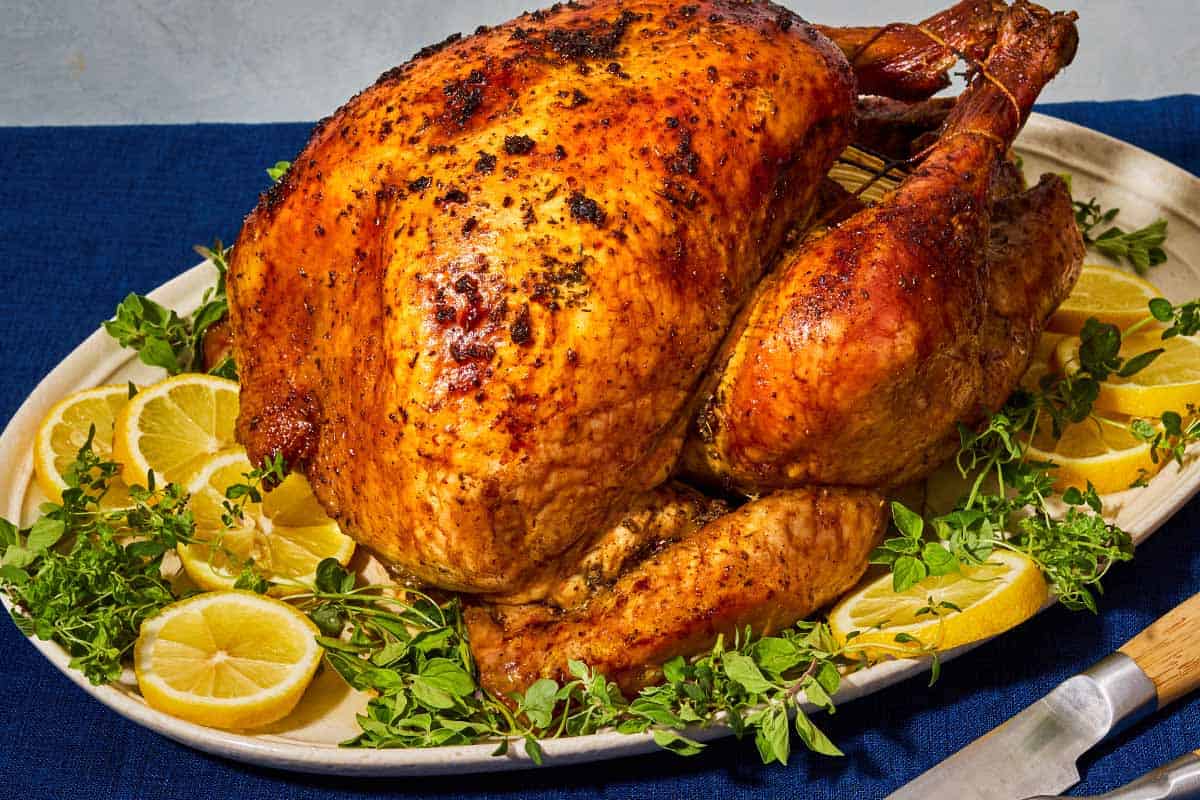
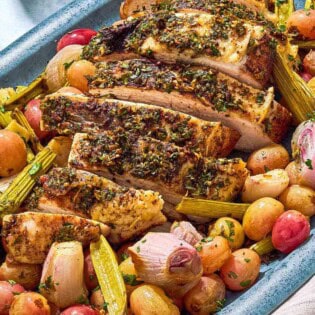
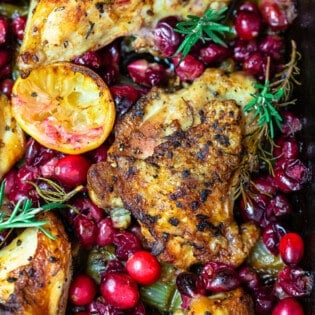
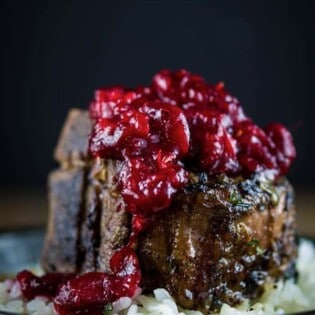
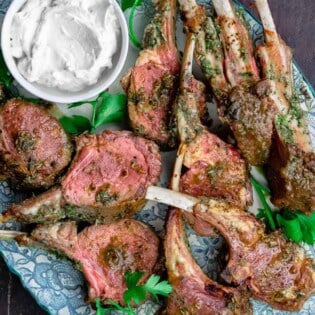
I have read and re-read this and I am not seeing that lemons is listed as an ingredient but is listed in the written part. Thanks for updating and excited to try this brine!
Hi, Laura. The lemon juice and zest are added in step 1 (“Prepare the Rub”) and the quartered lemons are added to the turkey’s cavity in step 5 (“Prepare the Turkey”). Hope you love the recipe!
Made this today! Oh it is so good!!!!!!!!! So very moist!! I used the wild Greek oregano. Also made my Oyster dressing; I used Irish Soda Bread, whatever bread we have leftover and this year I had a little Naan bread as well along with the celery, onions, broth and sage…also added some Za’atar for good measure! Gave it some oomph!!! Soooooo yummy!!!!!!!!!!!!!
Sounds scrumptious, April! Thanks for sharing!
Hi, April! I’m so glad you loved this Thanksgiving Turkey recipe. Thanks for taking the time to let us know. And your oyster stuffing sounds amazing! Since you love oysters should check out some of our oysters recipes on the site. We a recipe for raw oysters with different sauces, grilled oysters and baked oysters too!
My daughter-in-law has a severe pepper allergy. Would taking the pepper out affect the recipe adversely? Or could something else be substituted for the pepper? She can’t have white pepper either.
Hi, Kim! I’m Summer and I wrote this recipe. You can leave the pepper out. No worries. I hope you love the turkey.
Can I stuff the turkey after I do the dry brine?
Can I stuff the turkey using this dry brine recipe?
Hi, Gloria. We actually don’t recommend stuffing a whole turkey before cooking it for food safety reasons. Stuffing a turkey increases the risk of cross-contamination and food-borne illness.
Could I use this brine on a turkey breast?
Thank you
Sure!
How would I adapt this recipe for a 9 lb turkey breast?
Hi, Sandra. For a 9 pound breast, I would honestly use the same amount of rub/brine and just use less of it if necessary. Most dry brine recipes use 1 tablespoon of salt per pound and we use a lot less. The bird won’t be too salty, however if you’re concerned about it you can always just reduce the amount of rub by 1/3. We’ve never tried this particular recipe with a just a turkey breast, but we have an actual turkey breast recipe that you can use as a guide here. You can click here to find that.